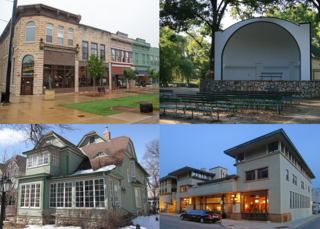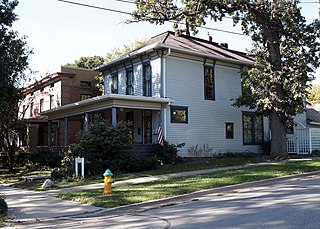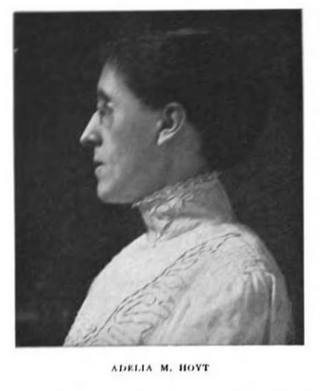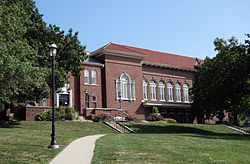
Des Moines is the capital and most populous city in the U.S. state of Iowa. It is the county seat of Polk County with parts extending into Warren County. It was incorporated on September 22, 1851, as Fort Des Moines, which was shortened to "Des Moines" in 1857. It is located on, and named after, the Des Moines River, which likely was adapted from the early French name, Rivière des Moines, meaning "River of the Monks". The city's population was 214,133 as of the 2020 census. The six-county metropolitan area is ranked 81st in terms of population in the United States, with 709,466 residents according to the 2020 census by the United States Census Bureau, and is the largest metropolitan area fully located within the state.

Mason City is a city and the county seat of Cerro Gordo County, Iowa, United States. The population was 27,338 in the 2020 census. Mason City is known for its musical heritage, high concentrations of renowned Prairie School style architecture, and a close connection with nearby Clear Lake.

Hoyt Sherman, a member of the prominent Sherman family, was an American banker. He served as a member of the Iowa House of Representatives in 1866.

The Gillioz Theatre is a historic theater located at Springfield, Missouri, United States. It was built by M. E. Gillioz of Monett, Missouri. Mr. Gillioz was in the business of building bridges, and the theater was built with steel and concrete. Wood was only used for handrails, doors, and doorframes. The original cost of the building was $300,000. Renovation costs totaled approximately $1.9 million.

All Saints Catholic Church is a parish church building in the Diocese of Des Moines. The building is located in Stuart, Iowa, United States. The parish used the building as its church until a devastating fire severely damaged the structure. The church was rebuilt and it now serves as a cultural center called the Historic All Saints/Saints Center for Culture and the Arts. It is listed on the National Register of Historic Places, and is a rare example of Neo-Byzantine architecture in the state of Iowa.

St. Luke's Hospital was a hospital building on a bluff overlooking downtown Davenport, Iowa, United States. It is listed on the Davenport Register of Historic Properties and the National Register of Historic Places. It has subsequently been torn down.

The James Sansom Carpenter House was significant to Des Moines cultural history from 1906 to 1939. The 13 acre property named Oakwood estate by its owners J. S. Carpenter and his Spouse Florence L. Carpenter because of the old growth oak forestation. The Carpenters' collection was deemed by art critics as one of the finest collections of etchings and lithographs in America. The house held the Carpenter collection of 125 paintings and 350 etchings. J. S. Carpenter was also known as Sannie or Sandy after his oddly spelled middle name. J. S. Carpenter, a bridge building magnet, founded the Des Moines Association of Fine Arts in 1916. The Association members each contributed $100.00 annually for the purchase of paintings and sculptures. The members also received a 25% discount on art purchased at Association events. Carpenter was known as the Guru of fine arts by the Des Moines community. Visiting artists and dignitaries came to Des Moines to sell their art and often stayed with the Carpenter's at Oakwood. Carpenter was president of the Association from its inception until his death of heart disease in 1939. The Association transformed into the Edmundson Art Museum in 1940 under the auspices of Association Executive member, and Carpenter's close friend Jay N. (Ding) Darling. Darling as President of the Edmundson Art Foundation merged the original collection into the present day Des Moines Art Center.

The Sherman Hill Historic District is located in Des Moines, Iowa, United States. It is one of the oldest residential neighborhoods in Des Moines. Single-family houses were constructed beginning around 1880 and multi-family dwellings were built between 1900 and 1920. The district encompasses 80 acres (0.32 km2) and 210 buildings and is bounded by 15th Street to the East, High Street to the South, Martin Luther King Parkway on the West, and School Street to the North. The historic district has been listed on the National Register of Historic Places since 1979.

The Henry Wallace House is an historic building located in Des Moines, Iowa, United States. It was the home of Henry Wallace who was an advocate for agricultural improvement and reform. The house was listed on the National Register of Historic Places as a contributing property in the Sherman Hill Historic District in 1979 and it has been individually listed since 1993.
Mercy College of Health Sciences is a private Roman Catholic college focused on healthcare and located in Des Moines, Iowa. Established by the Sisters of Mercy in 1899, Mercy College bachelor's degrees, associate degrees, and certificate programs in the health sciences.
The Des Moines Symphony (DMSO) is a United States symphony orchestra based in Des Moines, Iowa. The current conductor is Joseph Giunta. Established in 1937 as the Des Moines Civic Orchestra, it performs both Masterworks and Pops concerts as well as Iowa's largest single-day concert event, Yankee Doodle Pops. The orchestra principally performs at the Civic Center of Greater Des Moines in downtown Des Moines.
The following is a timeline of the history of the city of Des Moines, Iowa, US.

Agnes Weinrich was an American visual artist. In the early twentieth century, she played a critical role in introducing cubist theory to American artists, collectors, and the general public and became one of the first American abstractionists. A life-long proponent of modernist art, she was an active participant in the art communities of Provincetown and New York. Early in her career, she traveled widely in Europe and spent extended periods studying in Paris and Berlin. She also studied art in Chicago, Provincetown, and New York. During most of her career, she worked in a Provincetown studio during the warm months and a Manhattan studio during the cold ones. Weinrich's easel work included oil paintings, watercolors, and pastels. She also made block prints and etchings and drew using pencil and crayon. Her paintings, prints, and drawings appeared in solo and group exhibitions throughout her career and she received favorable critical attention both during her life and after her death.

Downtown Des Moines is the central business district of Des Moines, Iowa and the Greater Des Moines Metropolitan Area. Downtown Des Moines is defined by the City of Des Moines as located between the Des Moines River to the east, the Raccoon River to the south, Center Street to the north, and 18th and 15th Streets to the west.

Woodland Cemetery is the oldest cemetery in Des Moines, Iowa, having been established in 1848, before Des Moines was the state capital. It is a municipal cemetery owned and operated by the Des Moines Parks and Recreation Department. It covers 69 acres (28 ha) at the corner of 20th Street and Woodland Ave and is the site of over 80,000 graves.

The Iowa Federation of Colored Women's Clubs (IFCWC) was an umbrella organization serving African-American women's clubs in Iowa. The motto of IFCWC was "Sowing Seeds of Kindness", and the organization was affiliated with the National Association of Colored Women. The club produced a journal called the Iowa Colored Woman. IFCWC sent delegates to represent the state at national conventions and opportunities such as "Colored Women's day" at the 1939 New York World's Fair. The IFCWC is also known for creating a black women's dormitory for the University of Iowa before the school was fully integrated. The building has been listed on the National Register of Historic Places.

Adelia M. Hoyt was an American librarian, writer, and advocate for blind people.

Helen Sherman Griffith was an American author. An Iowan, she was the "prolific" author of the Letty Grey series of children's books, published by Penn Publishing Company of Philadelphia. She was the daughter of Hoyt Sherman and Sara Sherman, who was born and raised in Des Moines, Iowa at Hoyt Sherman Place. Helen's bedroom has been restored and is part of the Hoyt Sherman Place house museum.

The Des Moines Women's Club, founded in 1885 as the women's club movement swept through the United States, today serves the Des Moines community by providing scholarships, support for the local arts community, and other civic projects.

Calista Halsey Patchin was a journalist and artist based in Washington, D.C., and Des Moines, Iowa. Patchin was the first woman reporter hired by The Washington Post newspaper in 1878.





















